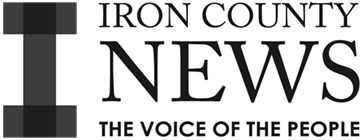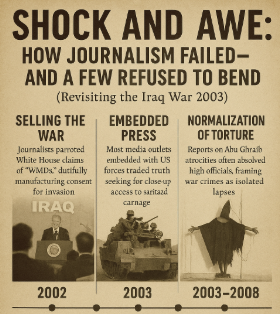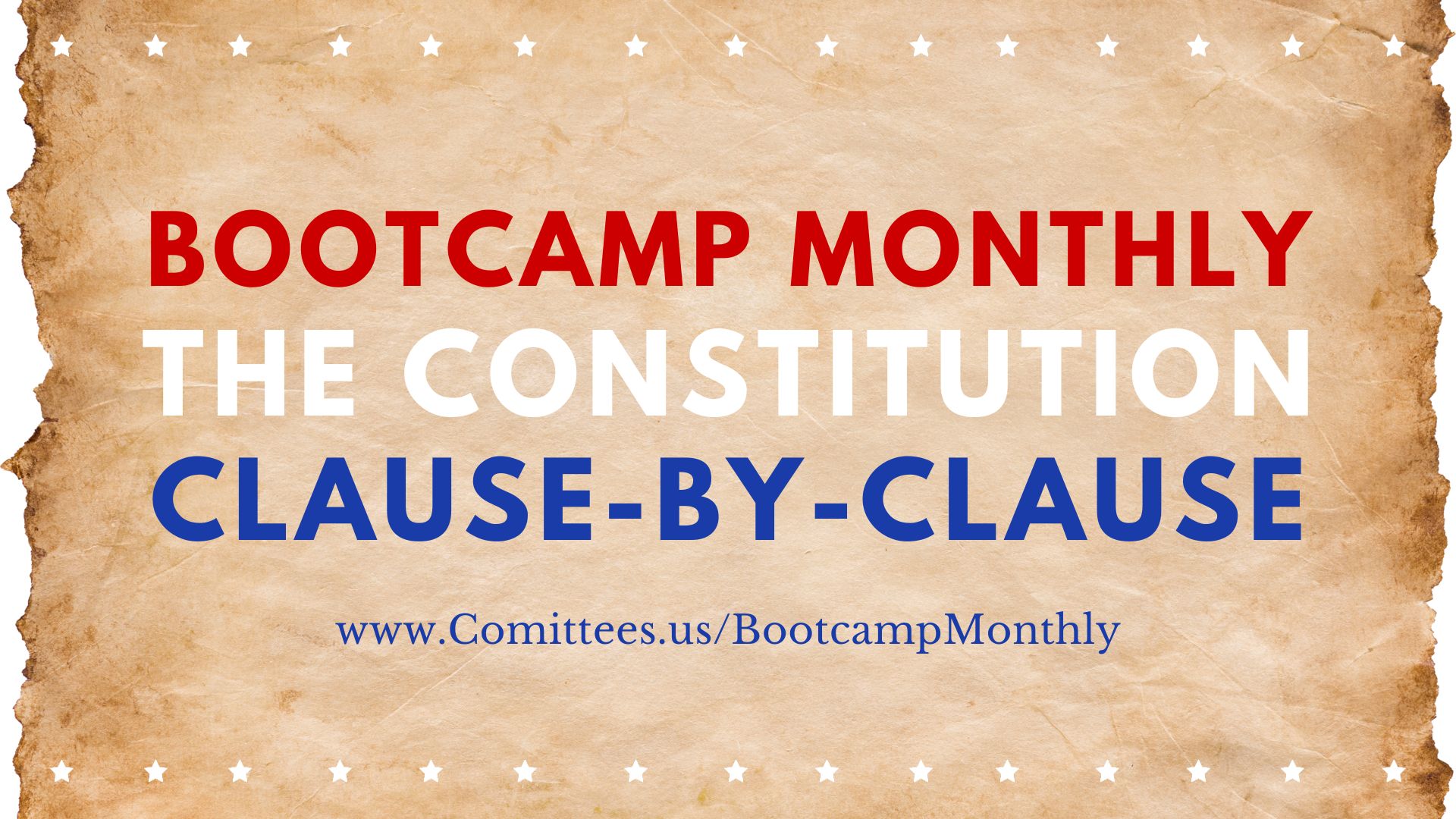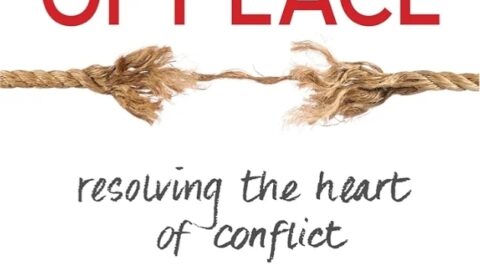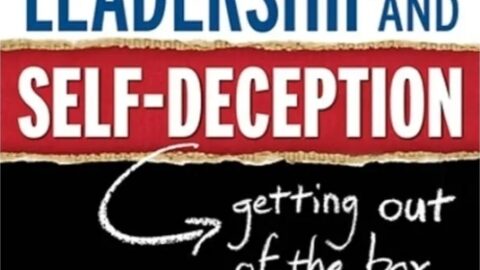“There is no more important struggle for American democracy than ensuring a diverse, independent and free media.” — Bill Moyers
Authors Note: We aren’t a Democracy, we are Republic.
In 2003, as the United States prepared to invade Iraq, most of America’s press corps marched in lockstep with the Bush administration. They repeated claims of weapons of mass destruction, whispered rumors of Saddam Hussein’s ties to al Qaeda, and amplified the language of fear — mushroom clouds, axes of evil, and liberation at gunpoint.
But one small chain of newspapers, Knight Ridder, asked a question that seems embarrassingly simple now: “Is it true?”
A Soldier’s Numbers
The film opens with Private First Class Adam Green testifying before Congress. He describes his experience in Iraq not through emotion but through numbers:
- 1.4 million — men and women serving in uniform.
- 555 — days between the 9/11 attacks and the invasion of Iraq.
- 19 — his age when he enlisted.
- 3 — hours in Iraq before his transport was hit by an IED.
- 6 — inches of shrapnel that nearly severed his spinal cord.
For Green, the numbers strip away abstraction. Behind each political decision is a body, a broken spine, a ruined life. “How the hell did this happen?” he asks.
Shock, Awe, and Spectacle
Television screens filled with streaks of fire and columns of smoke. 600 cruise missiles rained down on Baghdad. Precision bombs flattened infrastructure and homes alike. America watched transfixed by the spectacle of destruction — what the Pentagon called Shock and Awe.
The media relayed the images with little question, presenting overwhelming force as inevitability.
September 11 and the Search for an Enemy
In the chaos of 9/11, journalists scrambled for answers. Osama bin Laden and al Qaeda were quickly identified. But almost immediately, Defense Secretary Donald Rumsfeld, Richard Perle, Paul Wolfowitz, and other neoconservatives began floating Saddam Hussein as the real culprit.
The idea was implausible — Saddam a secular dictator, bin Laden a jihadist ideologue — yet it spread. Think tanks and op-eds argued that removing Saddam would spark a domino effect of democracy across the Middle East.
The Lone Dissenters
At Knight Ridder’s Washington bureau, reporters Warren Strobel, Jonathan Landay, and John Walcott refused to play stenographer.
Their sources in the intelligence community told them:
- No evidence linked Saddam Hussein to al Qaeda.
- No WMD programs were active.
- The aluminum tubes touted by the administration were unsuitable for uranium enrichment.
- The Pentagon had set up a shadow “Office of Special Plans” to cherry-pick intelligence supporting a war already decided upon.
While the New York Times and Washington Post repeated anonymous administration leaks, Knight Ridder reporters were filing stories that undercut the entire rationale for war. Most editors ignored them.
Congress and the Press Line Up
Despite deep skepticism in some corners, Congress voted overwhelmingly to authorize war. Senators Joe Biden, Hillary Clinton, John Kerry, and others gave their approval. The parallels to the Gulf of Tonkin Resolution — which escalated Vietnam — were obvious, but ignored.
Colin Powell, seen as the sober statesman, was persuaded to make the case at the United Nations. He discarded 80% of the “evidence” given to him, yet still presented a case built on shaky defectors and doctored intelligence. His credibility became the administration’s shield.
The Costs
Bush declared “Mission Accomplished” six weeks after the invasion. The war, however, had just begun.
The final toll, as recounted in the film’s epilogue:
- 17 years later: American troops still entangled.
- $2 trillion spent.
- 36,000 Americans killed or wounded.
- 1 million Iraqis dead or injured.
- 0 weapons of mass destruction ever found.
Journalism’s Reckoning
The New York Times eventually issued a public apology for its flawed Iraq coverage. Knight Ridder, though right all along, received little recognition in the moment.
John Walcott’s reminder to his reporters cuts to the heart of the story:
“We are not writing for the people who send other people’s kids to war. We are writing for the people whose kids get sent to war. When the government says something, you only have one question to ask: Is it true?”
The Lesson
Shock and Awe is not just about the Iraq War. It is about the failure of institutions — political, military, journalistic — and the heavy price of deference to power.
When government misleads, soldiers and civilians bleed. And when the press abandons its duty, truth becomes collateral damage.
The film stands as a warning: in times of crisis, the question “Is it true?” is not just journalism — it is Republic’s last defense.
NOTES:
1. Opening & Moral Context
- Bill Moyers: “There is no more important struggle for American democracy than ensuring a diverse, independent and free media.”
The film’s central theme: the press as the last safeguard.
2. Veterans Affairs Hearing
- Private First Class Adam Green testifies.
- He frames his experience through numbers:
- 1.4 million: active military.
- 555: days between 9/11 and Iraq invasion.
- 19: his age when enlisted.
- 3: hours in Iraq before IED destroyed transport.
- 6: inches from his spinal cord where shrapnel struck.
- He calls out policymakers: “How the hell did this happen?”
3. Shock & Awe Campaign
- News montage of U.S. military bombardment of Baghdad with cruise missiles and precision bombs.
- “Shock and Awe” presented as overwhelming military spectacle.
- Early push into Baghdad broadcasted as fast and powerful.
4. Journalist Training & Risk
- Knight Ridder reporters shown in “Gray Man Exercise” (kidnapping simulation).
- Lesson: survive captivity by blending in, not provoking.
- Highlights reporters’ personal risk covering wars.
5. September 11, 2001
- News clips of towers struck, Pentagon explosion, chaos in New York and Washington.
- Journalists scramble: family fear, White House possibly targeted.
- First attributions to Osama bin Laden / al Qaeda.
6. Early Iraq Theories
- Even as focus is on al Qaeda, Rumsfeld, Richard Perle, and neocons push Saddam Hussein as a suspect.
- Neocon belief: topple Saddam, spread democracy, secure Israel.
- Journalists skeptical: Saddam and Bin Laden unlikely allies.
7. Knight Ridder’s Reporting vs. Mainstream
- Warren Strobel, Jonathan Landay, John Walcott push back on Iraq claims.
- Sources in intelligence confirm no evidence of Saddam–al Qaeda link.
- Knight Ridder largely alone, while NYT, WaPo, cable news echo administration.
8. Nationalism vs. Patriotism
- Discussion: “patriotism smells like nationalism.”
- Warning parallels to Yugoslavia’s collapse.
9. Wolfowitz & Shadow Ops
- Reports of James Woolsey sent to Europe to find links between Saddam and 1993 WTC bombing.
- Secret “Office of Special Plans” (OSP) in Pentagon bypassing CIA/State, cherry-picking intel.
- Sources: “Decision is made first, then intel sought to justify.”
10. Administration Rhetoric
- Bush’s “Axis of Evil” speech.
- Cheney, Rumsfeld, Rice amplify Saddam’s WMD threat (“mushroom cloud” imagery).
- Powell skeptical but pressured.
11. Journalists’ Pushback
- Knight Ridder interviews insiders:
- No evidence of nuclear program.
- Aluminum tubes story misrepresented.
- Sources flatly deny WMD evidence (“searched every camel’s ass… no fucking way”).
- Strobel/Landay frustrated their accurate reporting ignored.
12. Congressional Authorization
- Debate over Authorization for Use of Military Force in Iraq.
- Senators including Biden, Clinton, Kerry vote yes.
- Echoes Gulf of Tonkin Resolution → Vietnam parallel.
13. Colin Powell’s UN Speech
- Powell presents Iraq WMD case with files vetted by CIA.
- Later revealed: much evidence discarded, cherry-picked intel highlighted.
- Powell becomes reluctant but key face of war case.
14. Press & Truth
- Walcott’s rallying cry: Knight Ridder reports for “military families,” not elites.
- Question they always ask: “Is it true?”
15. Public Resistance vs. Media Consensus
- Global protests rise against Iraq war.
- Yet major media & Congress align with Bush administration.
- Knight Ridder marginalized despite accurate reporting.
16. Invasion & Aftermath
- Bush declares “Mission Accomplished” six weeks after invasion.
- Numbers in closing:
- 17 years later: troops still deployed.
- $2 trillion financial cost.
- 36,000 American casualties.
- 1 million Iraqi casualties.
- 0 WMD found.
17. Film’s Final Message
- Truth suppressed in favor of war.
- Journalists who asked hard questions vindicated in hindsight.
- Reminder: when government fails, soldiers and civilians pay the price.
